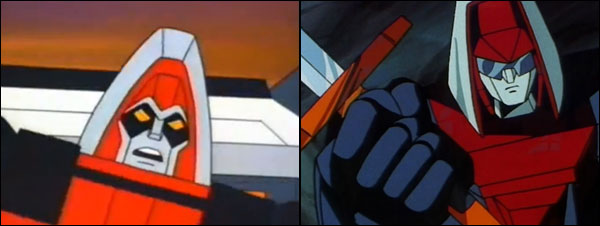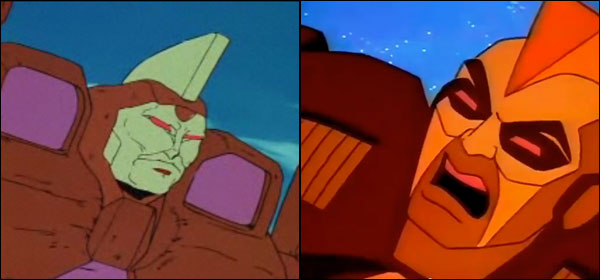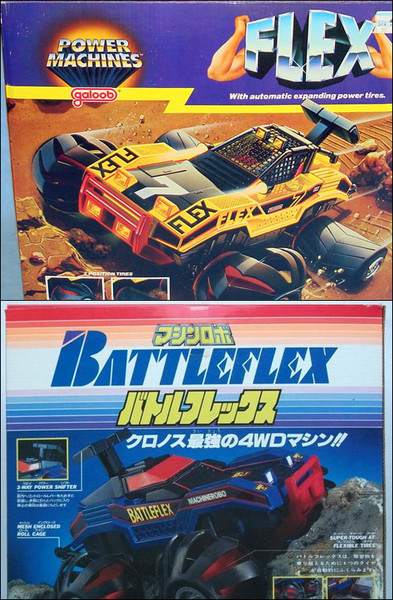The Mike Toole Show
More Than Meets The Eye
by Michael Toole,
Last week, I was talking to translator extraordinaire Neil Nadelman, who happens to be a good friend of mine. He'd recently wrapped up a long series (Sentai's Psychic Squad) and was ruminating on the pretty extreme volume of translation and subtitling work he's completed over the years. He related a humorous anecdote: a year or two prior, he'd been wandering the aisles in the dealer's room at Anime Weekend Atlanta, and spied Machine Robo DVD volume 3. “Huh,” he mused, “I wonder who translated that?” Of course, he'd done it; he just forgot.
This isn't the first time I've mentioned Machine Robo. Last year, I touched on the series in my column, committing one of my usual gaffes by attributing the origins of the series to toymaker Tomy. But it was actually Bandai who backed Machine Robo, as part of a complicated media and merchandising war with Takara. Takara had, years prior, created a neat set of transforming robot toys called Diaclone. Hasbro licensed these toys for US release, and commissioned Marvel Comics and Sunbow animation to create tie-in media-- and thus, Transformers was born, and rapidly imported straight back to Japan. The opposing action to Transformers actually came on two fronts, which just makes it funnier and more interesting to me. So relax and enjoy while I dish up some facts and prepare you for the inevitable day when your child looks up at you and, eyes wide, innocently asks “Mom/dad, where did the Gobots come from?”

Actually, the kid won't ask something like that unless you force your own misguided nostalgia on them by making them watch the cartoons you enjoyed decades ago. (Does anyone else do this? My nephews like Robotech, but are kinda meh on Star Blazers...) Fact is, Hasbro bought up the Gobots names and trademarks several years ago-- so while the designs won't all match, you can go out there and hunt up Transformers toys named Leader-1 and CY-kill. But the reason I'm writing this column is because of this particular phenomena:

See that? On the left, there's Fi-tor, from the Gobots. (The Gobots, by the way, all sport hilarious names like Dumper and Tork. Topless Robot breaks it down beautifully here.) On the right, it's Blue Jet from Machine Robo: Revenge of Cronos. The colors are slightly different, but that's totally the exact same robot design! Interestingly, Fi-tor is a bad guy, but the creatively-named Jet is a force for justice. Mostly, I'm stuck on the idea that two separate countries can take the exact same toy and create completely different animated adventures for it. And the best part is? The Gobots cartoons and toy lines are full of this multinational weirdness.
Take, for example, big bad CY-kill and big good Leader-1. These dudes are taken from Bandai's pre-cartoon Machine Robo toys, and so don't appear in the Japanese Machine Robo animation. However, a U.S. toy and hobby company called Monogram went to Tonka, who held the Gobots intellectual property, and licensed the characters names. Why, you ask? Well, they'd gone to Japan and separately licensed the rights to release model kits that just happened to be a transforming jet and motorcycle. Specifically, it was these two dudes:

Look familiar? They should! Those kits are totally the Cyclone and Legioss vehicles from Mospeada, which we western dorks know better as the New Generation segment of Robotech. I actually really like the radical recoloring job on the Cyclone; looks cool! The funny thing is, Monogram released several model kits based on the Gobots, but most were quite similar to the blocky, unsophisticated toy designs that would ensure Gobots’ eternal relegation to the trash bin of the 80s toy robot wars. So, these Mospeada kits really stood out, in more ways that one.
Beyond that, however, most of the Gobots came straight from Bandai's Machine Robo line, and since the toys predated the cartoons, we didn't get to see too many crazy anime versions of heroes and baddies like Bug Bite and Baron Von Joy. Machine Robo’s Rod Drill was known as Screw Head in our own crummy Hanna Barbera cartoon. Also, remember the Rock Lords? No, of course you don't; only I remember stupid stuff like that. The Rock Lords were probably the most amusingly strange point that transforming robot toys reached. Like, in the 80s, robots turned into vehicles first. Later, dinosaurs, insects, and animals would be added. This all made a certain kind of sense; you could pretty much envision meetings of toy execs and designers all agreeing that the only things kids would love more than robots that turn into trucks and planes are robots that turn into dinosaurs and tigers. But man, the Rock Lords? They turn into rocks. Yeah, that's pretty much how they disguise themselves. Take a gander:

The one on the left is the nefarious Devil Rock, whose name is occasionally used by suspicious social conservatives to describe heavy metal music. On the right is Magmar, his Gobots counterpart, who's voiced in the cartoon movie by the late Telly “Kojak” Savalas, sounding more bored than he ever did in his entire life. Yeah, if I was voicing a cartoon rock, I guess I'd be pretty bored, too. The good guy's name in this cartoon? Boulder. Many of these rock fighters show up in Machine Robo, but hilariously, my attempts to yield images or pictures just turned up lots of Nico Nico clips of Japanese fans laughing at the Gobots cartoons. Some things really are universal!
There are a number of other weird crossovers - the combining bad-guy Gobot Monsterous is actually the 6-robot bad guy team from Machine Robo, the amazingly-named Devil Satan Six. Even more interestingly, though, is the fact that partway through Machine Robo, our hero Rom starts driving around in this cool sentient jeep with expanding wheels called Battle Flex. It turns out that Battle Flex came all the way from America to help Rom, because it was originally this thing:

Yep, that's right—a toy from America was imported for a Japanese cartoon. This unusual example of an American toy heading upstream to appear in a Japanese cartoon based on Japanese toys that were also sold in America is just the kind of dumb nerd catnip that I love. There are a couple of other examples of bizarre crossovers in the Gobots toy line, too-- but I think my overall favorite is the car robot with the flattering name of Psycho. He looks like this:

In the inset is his animated robot form. Really attractive and imaginative, isn't it? Yeah, you can really see why the Gobots caught on the way they did. Anyway, that toy actually came from a most unexpected source:

Yep, “Psycho” is actually the Psychoroid, Cobra's futuristic car, from Space Adventure Cobra. It's kind of funny-- the thing only shows up a few times in the cartoon, but Popy made a toy, and that toy happened to transform. Bam! Instant Gobot. If you scare up a Gobots Psycho toy, you'll notice that the car's cabin has a little red dude and a little slivery figure sitting in the seats. That's totally Cobra and Lady, his android buddy. I like to think that, in the Gobots cartoon, Cobra is eternally trapped in the head of Psycho. Squint hard, and maybe you'll be able to make him out...
The toy and mecha anime game of the 80s is littered with weird doppelgangers like this. As the Gobots and Transformers duked it out for supremacy, the JC Penney chain licensed a set of toy robots of their own, under the title CONVERTORS. Now, a lot of these of the robots in this line were raided from anime properties that never made it here, like Dorvack and Galvion and Sasuraiger, but a few are even more familiar.

Yep, that's the good ship Orguss all right. The black paint job is kind of cool, though you'll note that they still resorted to using Japan-supplied key artwork for the packaging. I think my favorite part of these robot toys, who sadly never made the jump to American animation, is the fact that they all were apparently sentient and had weird backstories.

I mean, Zark sounds like kind of a dick, right? These things were showing up in JC Penney while Robotech was starting to air, which contributed to the general sense of excitement and confusion of kids who went completely bananas over this kind of shit. Were you one of those kids? I sure was!

Zark's brother, an obvious repaint of the awesome Strike Valkyrie, seems like an even bigger dick. But man, all he ever wanted to do was destroy all humans!
Broaden the search a little more, and you'll find even more entertainingly weird knockoffs and recasts. One of the better-known ones comes from Micronauts, a pretty slick rebranding of Tomy's Microman toys by American toymaker Mego. Mego had the right idea, taking the already cool toys and giving them neat backstories, comic book tie-ins-- you name it. But a couple of the most recognizable Micronauts, the heroic Force Commander and his Nemesis Baron Karza, will look oddly familiar to you if you're up on your Gō Nagai robotology:

Yep, these two are just repaints of Kotetsu Jeeg that somehow manage to out-weird the already weird-looking Jeeg. In fairness, the magnetic-limbed, spring-loaded Jeeg is an incredibly cool toy, and the Micronauts versions have pretty much all of the bells and whistles of the original. The Micronauts artwork you see above is from the Marvel comic, created by Bill Mantlo. It's kind of a neat story - Mantlo noticed the toys when his kid got one for Christmas in 1977 and, intrigued by the rudimentary stories on the box, went to Marvel editor-in-chief Jim Shooter and asked if they could get the rights to create a comic book from Mego. The answer was yes, and remarkably, Micronauts comics kept coming all the way through 1984, long after the toys had vanished from shelves. Tomy/Takara would launch a Microman resurgence in the 1990s, but there was never much of a corresponding Micronauts relaunch; more's the pity.
If you keep looking for unusual doubles and divergent products like this, you'll tread some familiar territory. Many older fans know that famous super robots like Great Mazinger and Reideen were rebranded as THE SHOGUN WARRIORS by Mattel in the late 1970s, but that's honestly a strange and expansive enough subject that it deserves its own column. A bit more recently, you've got the Robotech movie, which provides a baffling alternate ending to Megazone 23, plus cartoons like Ultimate Muscle, which wrapped up in Japan but had further episodes produced strictly for the overseas market. But ultimately, we'll start with the Gobots and Machine Robo, and end up on the other side of the Gobots coin: Transformers.
Now is actually a really good time to bring up the weirdly divergent American and Japanese Transformers cartoons, because DVD publisher Shout! Factory just spent the summer flooding shelves with budget-priced, subtitled only releases of the long-obscure Japan-only trilogy of Transformers cartoons, like Transformers Headmasters, Transformers: Victory, and best of all, Transformers - Super God Masterforce. Hey, if you're going to inject that kind of hubris directly into your cartoon's title, it must be good, right?!
In 1986, Hasbro partnered with notorious B-movie producer Dino De Laurentiis to create a big-budget, star-studded Transformers movie. The toy and cartoon popularity was at a fever pitch, so the time seemed right to strike. Well... it was, and it wasn't. The resulting movie is gorgeously-animated, barely-coherent fun that went on to become a cult classic, but on its release, it flopped pretty mightily. The thing is, Japan didn't get that Transformers movie. Not at first, anyway. Instead, they got the new Transformers cartoon, featuring Rodimus Prime, Ultra Magnus, and all those other robot heroes that we pretty much put up with while we patiently waited for the creators to get off their asses and resurrect Optimus Prime for us. But the toys’ popularity were cooling off in North America. As a result of all this, the meager offerings that Sunbow created for the international market and Japanese toymaker Takara's needs to keep their domestic market stoked diverged. The last American Transformers cartoon, a 3-partner called Transformers: Rebirth, aired in 1987. In Japan, the party kept on going.
Without the bridge of the movie, the timeskipped third Transformers season was called Transformers 2010 in Japan. Man, just think of that far-off future year of 2010 that happened two years ago! A short OVA, Scramble City, filled in a couple of details, but Toei jumped right back into the fray with a new full-length TV series, Transformers Headmasters, that picks up after Optimus Prime is resurrected. The show is solid enough, continuing the franchise's trend of entertaining characters and mostly mediocre animation. Really, I just like to remember Headmasters for its awesome dub.
See, in the dub that was produced for English-speaking pacific rim countries, they had some new character names. Spike was called “Sparkle” (remember to think of Shia Lebouf's movie character by that name from now on!), but even better, Blaster, the soulful ‘bot who turns into a boombox, was redubbed “Billy.” There's a part in the show where he gets his ass wrecked and rebuilt into Twincast, but in this amazing dub, they had a different name: “Blaster.” Yeahhhhh.

The subsequent shows, Super-God Masterforce and Victory, go to even weirder places. First, the Autobots hide themselves on Earth by shrinking and disguising themselves as people. I remember that one single episode of the original series addressed this concept, and it was kind of disturbing, like when you're watching the Muppets and catch a glimpse of the puppeteers. The Powermaster Optimus Prime that we knew and loved on these shores is introduced as God Ginrai, a fusion of a heroic Autobot and a tough Japanese trucker(!). Finale series Victory features yet another new leader, the Japan-only Star Saber, and puzzlingly returns to the episodic formula of the old American cartoons. The DVD sets are relatively threadbare, but a bargain at $20ish each-- and the aforementioned Neil Nadelman? He did some subtitling work on them, so the circle's complete.
After that point, though? We've been getting a steady diet of Transformers cartoons, both here at home and from abroad. The tide of engrossing, continuity-demolishing appearances of various awesome cartoon robots in rival toy lines and foreign cartoons has abated. It's cool that we have all of these great cartoons, and nice that the internet has dispelled the mystery of where everything came from, but I look back to this period with nostalgia-- there was this amazing sense of wonder and mystery when you could walk into a toy store and discover a brand-x robot that clearly looked exactly like the Matchbox Robotech toys at the department store down the street, but was something completely different.
Man, wouldn't it have been interesting if Gobots was animated in Japan, like in this commercial? Did you play with awesome converting robots as a kid? Do you still play with them now? Do you buy them for your kids, even though your kids don't like Transformers, because it gives you an excuse to enjoy them yourself? Sound off in the comments!
discuss this in the forum (25 posts) |